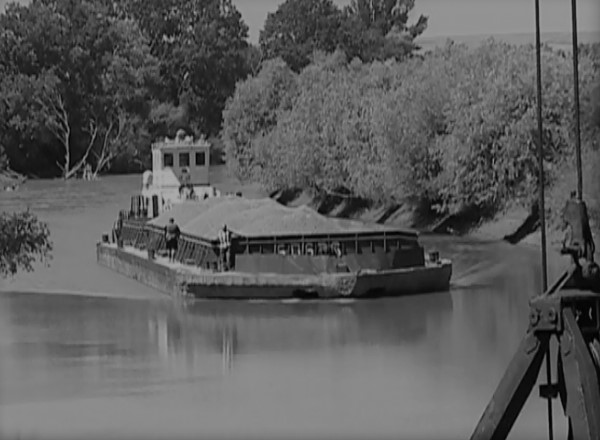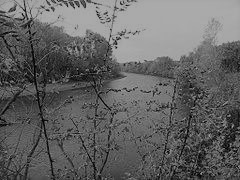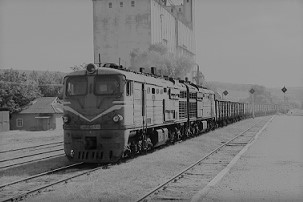
The Leova Port


|
Leova was a lively town.
The chief business of the town dealt with
grain, all type that grew in the vicinity in
abundance and was exported to Romania, to
Galatz-Braila, by boat on the Prut.
From the mouth of the river Prut, "Gura
Prutulia", where the river flows into the
Danube, the ships travel along the water only
with the help of the sailors who push it along
with long wooden poles. But, when the ships
reach the Danube, there is a large steamboat
there that pulls ten boats at a time into the
ports of Galati and Braila.
At the Prut river's edge, where the ships are
loaded, there is a lot of noise and
excitement. There can often be from 80-100
ships there that are loaded with various
grains. Those grains for export included
summer and winter wheat, barley, corn, and so
on.
The ships' owners as well as the sailors are
Greek, therefore every merchant had to know at
least enough Greek to be able to converse with
them.
The laborers who brought the grain to the
ships were almost all Jewish, each had his own
bundles and his horse and during loading time
they worked by the hour. Thankfully the cost
of living was not expensive, so they lived not
badly. They were organized in groups with a
manager over them. During the winter, or when
there was no work, they used to get advance
payment from the merchants, so they were able
to live quite nicely.
|

Barge on the Prut
|
In the year 1904 the
Russian Danube Navigation Company began
carrying grain on the River Pruth. They
have now for the purpose 38 river barges and
15 sea barges. They have granaries at
Leova, Fulcha, and Kagul, where they give
their customers gratuitous storage. The
freight depends on the season and on the
harvest. Grain is shipped in river
barges at the three stations named and
transhipped into sea barges at Reni.
In 1907 the cargo from Leova to Odessa by this
means of conveyance was 9 c. per poud [sic]
(11s.. 10 d.) per long ton, and about 24,000
tons were carried.
Great Britain, Foreign
Office
|

Prut River Near Leova
|
Moving downstream, the last
navigable tributary of any importance which is
encountered, the Pruth, lies wholly within
Roumainia. The river is navigable from
its mouth to Nemtzeni, located 370 km.
above. From the mouth to Leova, 227 km.
upstream, the river can be used by barges up
to 500 tons capacity of not more than 1 1/2m.
draught. From Leova to Nemtzeni, barges
of not more than 300 tons can be used with a
draught of not more than 60 cm.
The width of the stream varies from 80 to 120
meters; its depth is variable, sometimes
dropping to as little as two or three
feet. The course of the river is very
sinuous, its total length to Nemtzeni being
50% greater than the air-line distance.
Going upstream, barges are hauled by special
tow-boats or by oxen on the tow-path.
Downstream the barges descend with the
current. which varies from 0.4 to 0.6 meters
per second. Ice is expected during the
same months as for the Danube, i.e. from
December 1st to March 1st (90 days). Low
water generally occurs from July 1st to
October 1st. The smallest radius of
curvature is as little as 50 meters. The
banks are, in general, clay, rarely sand and
gravel. Such improvements as has been
undertaken has been done by means of
dredging. Snag are sometimes found in
the Pruth and are removed by the "Service
Hydraulique" of Roumainia.
|

Iargara Train Station
|
Amidst this rich
agricultural region, the Prut is an important
trade route. In Leova, wheat and corn are
shipped to Galati where the international
brokers are located. Trade along the river is
now suffering from the competition of the
railway, which is faster and allows for the
shipping of merchandise in smaller quantities,
while chartering a boat on the Prut is usually
prohibitively expensive. Originally, the train
station was to be built in Leova, but
fortunately, it was constructed 15 kilometers
to the east, near the village of Iargara.
Despite this distance, the station is used to
transport a portion of Leovan goods, as the
railroad can take them directly to
international ports, bypassing the hefty
duties imposed by the International Commission
of the Danube en route to Constanta, a
Romanian port on the Black Sea. In the port of
Leova, there is heavy trafficking of timber,
coming in on rafts from the Carpathians of
Bukovina.
|

|




